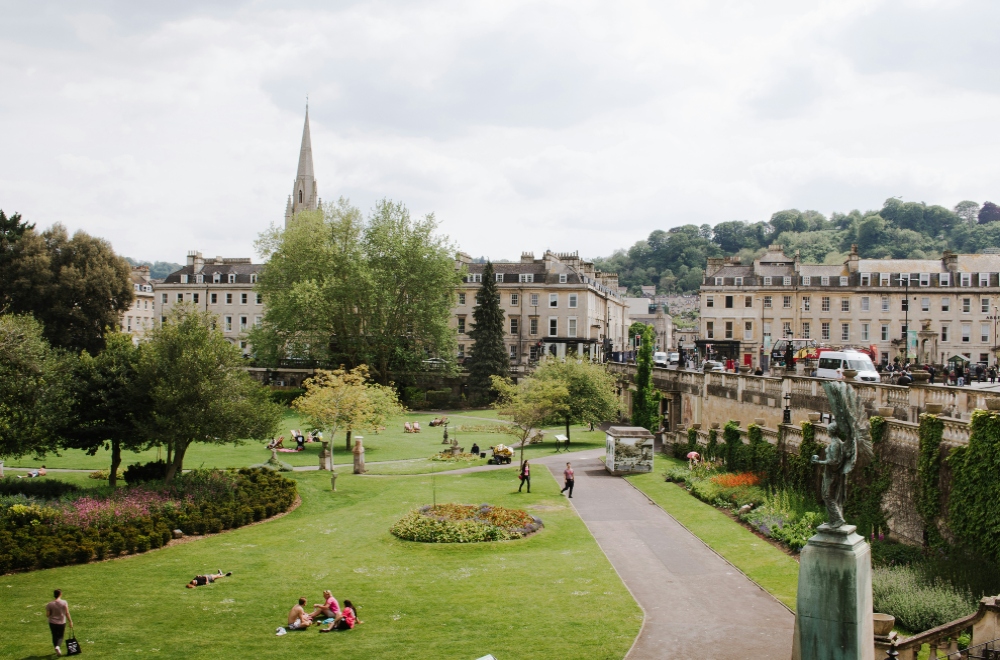It’s like walking into a living postcard when you’re in Bath where honey-colored Georgian terraces meet ancient Roman stones. With its cobblestone streets and hundreds of centuries-old architectural marvels, this UNESCO World Heritage city makes it surprisingly easy to see all Bath attractions without getting too tired. If you want to see Bath’s landmarks, you don’t need to make a complicated plan or stick to a strict schedule. All you need is a Bath hop-on hop-off bus ticket and a desire to learn about the city’s history.
Start Your Journey at the Heart of Roman Bath
The Roman Baths are the jewel in the crown of Bath. Every year, more than 1.3 million people come to see what’s left of Britain’s most impressive Roman spa. These amazingly well-preserved ruins tell the story of Aquae Sulis, the Roman settlement that gave Bath its name. They were built around 70 AD on natural hot springs that still bubble up at 46°C.
- The complex has four main parts: the Sacred Spring, the Roman Temple, the Bath House, and a museum with things that show how people lived in the past.
- Audio guides in twelve languages help visitors find their way through the changing rooms, plunge pools, and the beautiful Great Bath, where Romans used to meet up with friends and drink mineral-rich water.
- At the end of the experience, you can try the famous spa water in the Pump Room next door, though people have very different opinions about how it tastes.

Image credit: Hulki Okan Tabak for Unsplash
Once you know about this Roman background, the things to do in Bath have even more meaning. Celtic tribes and later Roman settlers were drawn to the thermal springs, which are still flowing today and produce 1,170,000 liters of hot water every day through the same geological processes that have been at work for thousands of years.
[product_card="38707, 41271, 41272"]
Discover Georgian Architectural Masterpieces
Bath’s transformation into Britain’s most beautiful Georgian city created the harmony of architecture that earned it UNESCO status. The Royal Crescent, which is made up of thirty terraced houses arranged in a graceful arc and designed by John Wood the Younger between 1767 and 1775, is the best example of this. This half-circle of honey-colored Bath stone and well-kept lawns is a great example of Georgian city planning.
The Circus, which is only a short walk away, is a perfect circle of townhouses designed by John Wood the Elder that were influenced by both Roman architecture and ancient British sites like Stonehenge. Artist Thomas Gainsborough and Prime Minister William Pitt the Elder were both famous Bath residents, which shows that it was a popular place for people to meet and socialize.
Bath sightseeing reaches its peak at these Georgian landmarks because they represent more than beautiful buildings – they showcase a whole social revolution that made Bath the most fashionable place in Britain in the 18th century.

Image credit: Martina Jorden for Unsplash
Navigate Bath Abbey’s Sacred Spaces
Bath Abbey, which stands tall in the middle of the city, has been the center of Bath’s spiritual life for more than a thousand years. The current building, which was finished in the early 1600s, replaced churches that were built as early as 757 AD. In 973 AD, King Edgar was crowned here. He was the first king of England to rule over all the Anglo-Saxon kingdoms.
The Abbey’s architecture is Perpendicular Gothic, and it has 52 beautiful stained glass windows, soaring fan vaulting, and the famous angels climbing ladders on the west facade. For a small donation, people can look around inside, or they can buy tickets for the tower tour and climb 212 steps to get a view of all of Bath’s rooftops.
The Abbey is a great example of how to plan a day trip to Bath: most of the city’s major attractions are close together, so visitors can easily go from Roman ruins to medieval sacred spaces to Georgian elegance.

Image credit: Elizabeth Jamieson for Unsplash
Cross the Unique Pulteney Bridge
Pulteney Bridge is one of the most photographed places in Bath and one of the strangest ways to cross a river in the world. It was built in 1774 and was modeled after Florence’s Ponte Vecchio. It is one of only four bridges in the world with shops on both sides.
The bridge is a great place to see the falling water of the Pulteney Weir, and it looks even more magical at night when it is lit up. The nearby Parade Gardens provide riverside relaxation with unobstructed bridge views – an ideal spot for picnics or simply watching Bath life unfold.
This location demonstrates the best way to see Bath – combining iconic landmarks with practical amenities like riverside gardens, shopping opportunities, and scenic photo spots all within a few steps.

Image credit: Martina Jorden for Unsplash
Experience Bath’s Living Heritage Through Walking Tours
Are there walking tours of the city? Absolutely, and they represent one of the most enriching ways to understand Bath’s layered history. The Mayor of Bath’s Honorary Guides offer free daily tours. The tours reveal stories hidden behind familiar facades. These volunteer guides, with decades of local knowledge, share anecdotes about ordinary people whose lives shaped extraordinary Bath.
For specialized interests, numerous themed tours explore Jane Austen’s Bath, Bridgerton filming locations, ghost stories, and literary connections. Bath Adventures and Bath Insider Tours provide both group and private options, while Strictly Jane Austen offers period costume experiences for literature enthusiasts.
Walking tours excel because Bath’s compact size – covering just 23 acres within the original medieval walls – makes every street accessible. Professional Blue Badge guides weave together Roman foundations, Georgian developments, and modern Bath life into compelling narratives that transform casual sightseeing into memorable education.

Image credit: Cande Westh for Unsplash
Consider Hop-On Hop-Off Bus Tours for Comprehensive Coverage
For visitors wanting to maximize their time while minimizing walking, hop-on hop-off bus tours offer strategic advantages. TootBus Bath operates two complementary routes: the City Tour covering central landmarks and the Skyline Tour exploring Bath’s surrounding countryside.
The City Tour connects 16 major attractions including Roman Baths, Royal Crescent, Jane Austen Centre, and Bath Abbey with buses running every 20-60 minutes. The Skyline Tour features 21 stops highlighting Prior Park Landscape Gardens, University of Bath, and panoramic city viewpoints from surrounding hills.
These services become particularly valuable for understanding must-see places in Bath geography. Visitors quickly grasp how Roman Bath, Georgian Bath, and modern Bath interconnect across the landscape. The 24-hour passes include multilingual audio commentary, free Wi-Fi, and discount booklets for major attractions.
Plan Your Perfect Bath Day
Creating an effective Bath in a day itinerary starts with prioritizing your interests.
- History enthusiasts should begin early at the Roman Baths (opens 9 AM) to avoid crowds. Then move to Bath Abbey before exploring Georgian architecture.
- Literature fans might reverse this order, starting at the Jane Austen Centre before afternoon tea at the Pump Room.
- Bath attractions cluster around three main areas: the Roman/Abbey precinct, the Georgian quarter (Royal Crescent/Circus), and Pulteney Bridge district.
- This geographic concentration means easily reaching between major sites takes 10-15 minutes maximum.
- Smart timing matters: Roman Baths and Abbey attract morning crowds, Georgian areas remain busy throughout the day, while evening light transforms Pulteney Bridge into pure magic.
- Many visitors find the best way to see Bath involves mixing structured attractions (Roman Baths, Abbey) with leisurely exploration of Georgian streets and riverside walks.
Wrapping Up
The beauty of Bath lies not just in individual landmarks but in how they connect – Roman foundations supporting Georgian elegance, ancient springs feeding modern spas, medieval abbey bells chiming over contemporary cafes. This layered history makes Bath uniquely accessible. Whether you choose guided tours, independent exploration, or hop-on hop-off convenience, the city’s compact scale and concentrated Bath attractions ensure every visitor can craft their perfect Bath experience.


